| 登録情報 | データベース: PDB / ID: 7k7j
|
|---|
| タイトル | EphB6 receptor ectodomain |
|---|
 要素 要素 | Ephrin type-B receptor 6 |
|---|
 キーワード キーワード | TRANSFERASE / receptor tyrosine kinase |
|---|
| 機能・相同性 |  機能・相同性情報 機能・相同性情報
positive regulation of T cell costimulation / type IV hypersensitivity / ephrin receptor activity / activated T cell proliferation / cell surface / ATP binding / plasma membrane類似検索 - 分子機能 ephrin a2 ectodomain / Tyrosine-protein kinase ephrin type A/B receptor-like / Tyrosine-protein kinase ephrin type A/B receptor-like / Ephrin receptor type-A /type-B / Ephrin receptor ligand binding domain / Tyrosine-protein kinase, receptor class V, conserved site / Ephrin receptor, transmembrane domain / : / Ephrin receptor ligand binding domain / Ephrin type-A receptor 2 transmembrane domain ...ephrin a2 ectodomain / Tyrosine-protein kinase ephrin type A/B receptor-like / Tyrosine-protein kinase ephrin type A/B receptor-like / Ephrin receptor type-A /type-B / Ephrin receptor ligand binding domain / Tyrosine-protein kinase, receptor class V, conserved site / Ephrin receptor, transmembrane domain / : / Ephrin receptor ligand binding domain / Ephrin type-A receptor 2 transmembrane domain / Receptor tyrosine kinase class V signature 1. / Receptor tyrosine kinase class V signature 2. / Eph receptor ligand-binding domain profile. / Ephrin receptor ligand binding domain / Putative ephrin-receptor like / SAM domain (Sterile alpha motif) / Galactose-binding domain-like / SAM domain profile. / Sterile alpha motif. / Sterile alpha motif domain / Sterile alpha motif/pointed domain superfamily / Fibronectin type III domain / Growth factor receptor cysteine-rich domain superfamily / Fibronectin type 3 domain / Fibronectin type-III domain profile. / Galactose-binding-like domain superfamily / Fibronectin type III / Fibronectin type III superfamily / Serine-threonine/tyrosine-protein kinase, catalytic domain / Protein tyrosine and serine/threonine kinase / Jelly Rolls / Immunoglobulin-like fold / Protein kinase domain profile. / Protein kinase domain / Immunoglobulins / Protein kinase-like domain superfamily / Immunoglobulin-like / Sandwich / Mainly Beta類似検索 - ドメイン・相同性 |
|---|
| 生物種 |  Homo sapiens (ヒト) Homo sapiens (ヒト) |
|---|
| 手法 |  X線回折 / X線回折 /  シンクロトロン / シンクロトロン /  分子置換 / 解像度: 3.004 Å 分子置換 / 解像度: 3.004 Å |
|---|
 データ登録者 データ登録者 | Goldgur, Y. / Himanen, J. |
|---|
 引用 引用 |  ジャーナル: Plos One / 年: 2021 ジャーナル: Plos One / 年: 2021
タイトル: Structure of the EphB6 receptor ectodomain.
著者: Mason, E.O. / Goldgur, Y. / Robev, D. / Freywald, A. / Nikolov, D.B. / Himanen, J.P. |
|---|
| 履歴 | | 登録 | 2020年9月22日 | 登録サイト: RCSB / 処理サイト: RCSB |
|---|
| 改定 1.0 | 2021年4月7日 | Provider: repository / タイプ: Initial release |
|---|
| 改定 1.1 | 2021年4月14日 | Group: Database references / カテゴリ: citation / citation_author
Item: _citation.journal_volume / _citation.page_first ..._citation.journal_volume / _citation.page_first / _citation.page_last / _citation.title / _citation_author.identifier_ORCID / _citation_author.name |
|---|
| 改定 1.2 | 2023年10月18日 | Group: Data collection / Database references / Refinement description
カテゴリ: chem_comp_atom / chem_comp_bond ...chem_comp_atom / chem_comp_bond / database_2 / pdbx_initial_refinement_model
Item: _database_2.pdbx_DOI / _database_2.pdbx_database_accession |
|---|
| 改定 1.3 | 2024年10月16日 | Group: Structure summary
カテゴリ: pdbx_entry_details / pdbx_modification_feature
Item: _pdbx_entry_details.has_protein_modification |
|---|
|
|---|
 データを開く
データを開く 基本情報
基本情報 要素
要素 キーワード
キーワード 機能・相同性情報
機能・相同性情報 Homo sapiens (ヒト)
Homo sapiens (ヒト) X線回折 /
X線回折 /  シンクロトロン /
シンクロトロン /  分子置換 / 解像度: 3.004 Å
分子置換 / 解像度: 3.004 Å  データ登録者
データ登録者 引用
引用 ジャーナル: Plos One / 年: 2021
ジャーナル: Plos One / 年: 2021 構造の表示
構造の表示 Molmil
Molmil Jmol/JSmol
Jmol/JSmol ダウンロードとリンク
ダウンロードとリンク ダウンロード
ダウンロード 7k7j.cif.gz
7k7j.cif.gz PDBx/mmCIF形式
PDBx/mmCIF形式 pdb7k7j.ent.gz
pdb7k7j.ent.gz PDB形式
PDB形式 7k7j.json.gz
7k7j.json.gz PDBx/mmJSON形式
PDBx/mmJSON形式 その他のダウンロード
その他のダウンロード 7k7j_validation.pdf.gz
7k7j_validation.pdf.gz wwPDB検証レポート
wwPDB検証レポート 7k7j_full_validation.pdf.gz
7k7j_full_validation.pdf.gz 7k7j_validation.xml.gz
7k7j_validation.xml.gz 7k7j_validation.cif.gz
7k7j_validation.cif.gz https://data.pdbj.org/pub/pdb/validation_reports/k7/7k7j
https://data.pdbj.org/pub/pdb/validation_reports/k7/7k7j ftp://data.pdbj.org/pub/pdb/validation_reports/k7/7k7j
ftp://data.pdbj.org/pub/pdb/validation_reports/k7/7k7j リンク
リンク 集合体
集合体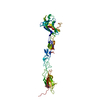
 要素
要素 Homo sapiens (ヒト) / 遺伝子: EPHB6 / 細胞株 (発現宿主): HEK293 / 発現宿主:
Homo sapiens (ヒト) / 遺伝子: EPHB6 / 細胞株 (発現宿主): HEK293 / 発現宿主:  Homo sapiens (ヒト) / 参照: UniProt: F8WCM8
Homo sapiens (ヒト) / 参照: UniProt: F8WCM8 X線回折 / 使用した結晶の数: 1
X線回折 / 使用した結晶の数: 1  試料調製
試料調製 シンクロトロン / サイト:
シンクロトロン / サイト:  APS
APS  / ビームライン: 24-ID-C / 波長: 0.9792 Å
/ ビームライン: 24-ID-C / 波長: 0.9792 Å 解析
解析 分子置換
分子置換 ムービー
ムービー コントローラー
コントローラー




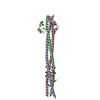
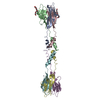
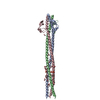
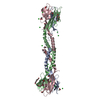
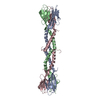
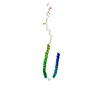
 PDBj
PDBj





